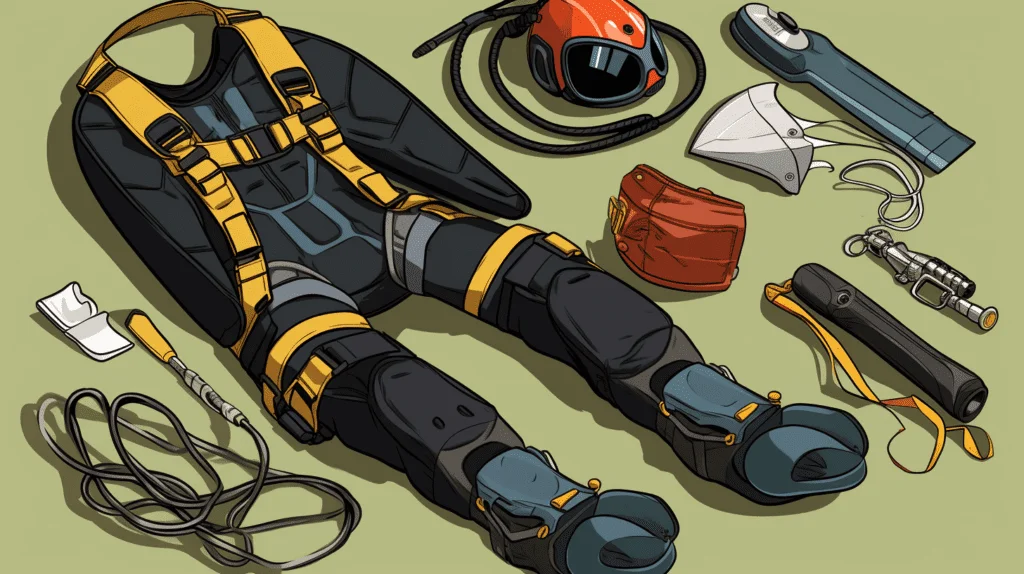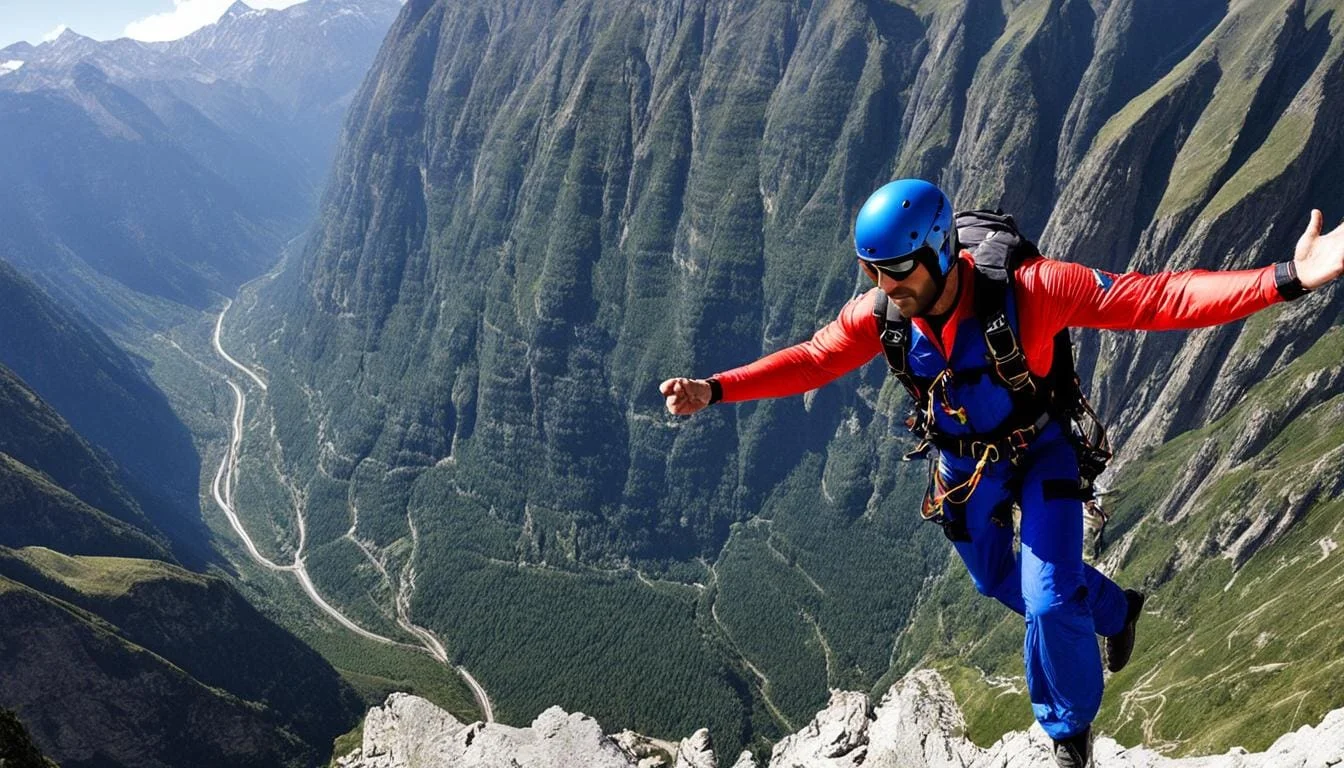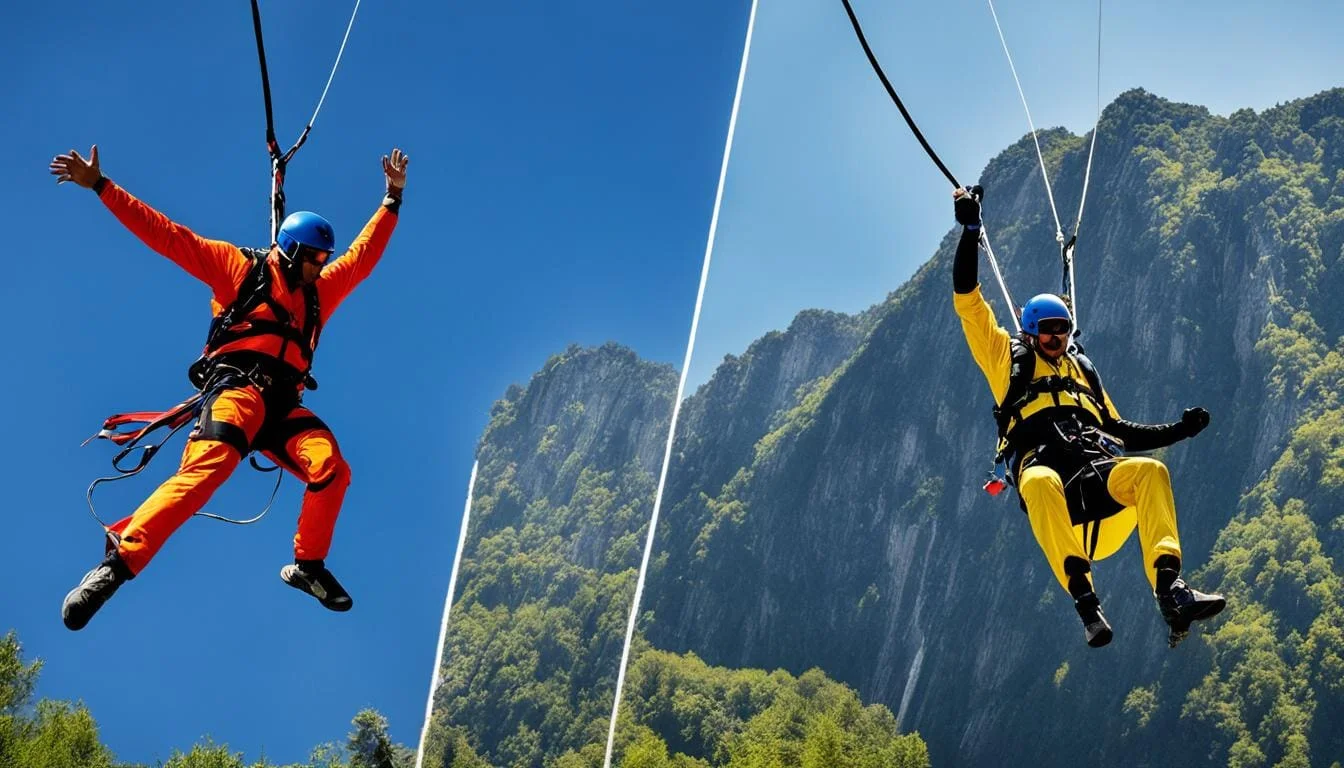BASE jumping is an exhilarating sport that pushes the boundaries of altitude, but just how low can you go? In this article, we will explore the height limits and requirements for BASE jumping, focusing on the minimum altitude at which jumps are performed.
We will also discuss the risks and safety measures associated with low-level jumps, providing valuable insights for both experienced jumpers and those curious about the sport.
But for those of you who want an instant answer to…
How Low Can You Base Jump?
The minimum recommended height for base jumping is typically around 100 meters (328 feet), but it’s extremely risky and requires significant experience and skill. We’ve seen even riskier jumps ranging from 25-30 meters. Always prioritize safety.
Key Takeaways
Understanding BASE Jumping Altitude and Equipment
When it comes to BASE jumping, altitude plays a crucial role in determining the level of risk and excitement involved. Unlike traditional skydiving, BASE jumps are made at much lower altitudes, adding an extra layer of intensity to the sport. This article will explore the intricacies of BASE jumping altitude and the equipment utilized for these exhilarating descents.
Low BASE jumps are typically performed without a slider reefing device on the parachute, allowing for quicker deployments. The canopies used in BASE jumping are designed to open quickly and are typically attached to an anchor up top with a break cord for low jumps. This setup ensures a rapid descent from lower altitudes, adding to the adrenaline-charged thrill of the experience.
BASE jumping altitudes can vary, with the minimum height for jumps typically being around 25-30 meters. This low altitude requires precise skill and careful planning to ensure a successful landing.
Safety guidelines and regulations are in place to protect jumpers and bystanders, including factors such as weather conditions, wind speed, and the technical capabilities of the parachutes used. These guidelines help to minimize the risks associated with low-level jumps.

BASE jumping is considered a dangerous extreme sport, with a history of deaths and accidents. It is essential for participants to understand and adhere to the safety guidelines and regulations in place to mitigate these risks. With the right equipment, proper training, and a responsible approach, BASE jumping can provide an exhilarating experience like no other.
Base Jumping Altitude Safety Guidelines
Understanding the importance of safety in BASE jumping is paramount. When it comes to planning a low BASE jump, there are several key guidelines to consider:
- Check weather conditions: Wind speed, direction, and other weather factors can significantly impact the safety of a jump. It is crucial to assess these conditions and make informed decisions accordingly.
- Inspect equipment: Regularly check the condition of your parachute, harness, and other gear. Any signs of wear or damage should be addressed immediately to ensure safe jumps.
- Training and experience: BASE jumping requires a high level of skill and experience. Proper training from certified instructors is essential to understand the technical aspects of the sport and develop the necessary skills to handle different situations.
By following these safety guidelines and taking a responsible approach, BASE jumpers can enjoy the thrill and excitement of low-altitude descents while minimizing the inherent risks involved.
| BASE Jump Altitude: | Variations in altitude levels for BASE jumps. |
|---|---|
| Lowest Point for BASE Jumping: | The minimum height from which a BASE jump can be performed, typically around 25-30 meters. |
| Base Jump Safety Guidelines: | Rules and recommendations to ensure the safety of BASE jumpers, including equipment inspections, weather considerations, and training requirements. |
| Extreme Sports Altitude Regulation: | Regulations and guidelines specific to extreme sports, including BASE jumping, to prevent accidents and ensure participant safety. |
Exploring the Minimum Heights for BASE Jumps
BASE jumping enthusiasts often seek the thrill of lower jumps, but there are limits to how low you can safely go. The minimum height for BASE jumps can vary depending on various factors, including safety considerations and technical capabilities.
Typically, low-level BASE jumps are performed at altitudes as low as 25-30 meters, but it’s widely recommended to go no lower than 100 meters. The low height allows for a fast deployment of the parachute without the need for a slider reefing device, providing an exhilarating experience for the jumper.
When performing low BASE jumps, it is crucial to take into account the safety measures and equipment required for such descents. The canopies used in BASE jumping are specially designed to open quickly and provide a stable descent.
They are typically attached to an anchor up top with a break cord, ensuring a secure connection during the jump. Additionally, jumpers must adhere to the safety guidelines and regulations set forth by authorities to minimize the risks associated with low-altitude jumps.

“Low BASE jumps provide a unique rush of adrenaline, but it’s essential to approach them with caution,”
Says John Kravan, a seasoned BASE jumper.
“Understanding the technical aspects, having the right equipment, and following safety protocols are paramount in ensuring a safe and thrilling experience.”
While BASE jumping allows enthusiasts to experience the thrill of descending from low altitudes, there are specific safety considerations and limitations. Understanding the minimum heights for BASE jumps and following the necessary safety measures are essential for a successful and safe descent.
By prioritizing safety and adhering to regulations, BASE jumpers can continue to enjoy the exhilaration of lower jumps while mitigating the risks associated with the extreme sport.
The Adrenaline-Charged Thrill of Low BASE Jumps
Low BASE jumps offer a unique blend of heart-pounding thrill and intense focus that only a select few dare to experience. Descending from lower altitudes requires a combination of:
- Skill
- Precision
- Sheer courage
As adrenaline courses through your veins, every moment becomes a test of mental and physical prowess.
With BASE jumping, the rush begins as you stand on the edge, looking down at the earth below. The feeling of weightlessness as you leap into the void is both exhilarating and humbling.
The wind rushes past, the world blurs, and time seems to stand still. It’s a moment of pure intensity that can only be truly understood by those who have taken the leap.
However, it’s important to note that low BASE jumps come with their own set of challenges and restrictions. Due to the lower altitude, jumpers have less time to react and correct any issues that may arise during the descent.
This places a greater emphasis on precise canopy control, quick reaction times, and a thorough understanding of the equipment being used.
Furthermore, the risks associated with low jumps cannot be underestimated. While BASE jumping is already considered a dangerous sport, low-level jumps heighten the inherent dangers. It is crucial for jumpers to have a comprehensive understanding of safety guidelines, as well as the physical and mental requirements necessary to mitigate these risks.

| Low BASE Jumps: Key Considerations |
|---|
| 1. Safety first: Understanding and adhering to safety guidelines and regulations is paramount. It is essential to be well-versed in proper equipment usage, emergency procedures, and risk management strategies. |
| 2. Training and experience: Low jumps require a higher level of skill and experience due to the increased stakes involved. Proper training, mentorship, and a gradual progression in altitude are necessary to build the necessary expertise. |
| 3. Equipment and gear: Using reliable, well-maintained equipment is vital. Low-altitude BASE jumps often require specific parachute configurations and modifications to ensure quick and reliable deployments. |
| 4. Legal and environmental considerations: It is crucial to respect local laws and regulations regarding BASE jumping, as well as the impact on the surrounding environment and communities. Seek permission and guidance from relevant authorities whenever necessary. |
The Thrill of Low BASE Jumps: A Test of Skill and Courage
“Low BASE jumps offer a thrilling experience unlike anything else. It pushes your limits, mentally and physically, as you navigate the challenges unique to lower altitudes. It’s a test of skill, precision, and sheer courage that few are brave enough to take on. But for those who do, the rewards are beyond compare.”
Whether you’re an experienced BASE jumper or curious about exploring the world of extreme sports, low BASE jumps present an irresistible allure. However, it’s crucial to approach this sport with caution, respect, and a deep understanding of the risks involved.
Only by prioritizing safety, proper training, and responsible decision-making can you fully embrace the electrifying thrill of low-level BASE jumps. So, if you’re ready to defy gravity and experience the rush of a lifetime, prepare yourself for the intense adventure that awaits.
Considerations for Safety in Low BASE Jumps
Safety should always be a top priority when engaging in low BASE jumps, and understanding and adhering to safety guidelines is paramount. The unique challenges and risks associated with descending from lower altitudes require careful preparation and attention to detail. Here, we outline some key safety measures to consider before embarking on a low BASE jump.
Choosing the Right Equipment
When participating in low BASE jumps, it is essential to use specialized equipment designed for this type of descent. The canopies used in BASE jumping are specifically designed to open quickly, allowing for rapid deployment at lower altitudes.
These canopies are typically attached to an anchor up top with a break cord, ensuring a controlled descent while minimizing the risk of entanglements. Additionally, it’s crucial to check and maintain all gear regularly, including the parachute, harness, and other safety equipment, to ensure optimal performance and reliability.

Understanding Weather and Environmental Conditions
Weather conditions play a crucial role in the safety of any BASE jump, especially those performed at lower altitudes. Wind speed, direction, and turbulence can significantly affect the stability and control of the parachute during descent.
Monitoring weather forecasts and staying informed about local wind patterns is essential to make informed decisions about when it is safe to attempt a low BASE jump. Furthermore, being aware of environmental conditions, such as the presence of obstacles or changing terrain, can help prevent accidents and ensure a smoother descent.
| Safety Guidelines to consider for Low BASE Jumps | Importance |
|---|---|
| Complete comprehensive training and acquire proper certifications. | Ensures knowledge of safety procedures and techniques. |
| Perform thorough inspections of all equipment before each jump. | Reduces the risk of equipment failure or malfunction. |
| Plan and execute jumps with experienced and trained spotters. | Provides additional safety measures and guidance during the jump. |
| Observe and respect local regulations and restrictions regarding BASE jumping. | Maintains legal compliance and helps prevent accidents. |
Adhering to Safety Guidelines
Before attempting low BASE jumps, it is essential to undergo thorough training and acquire the necessary certifications to ensure a comprehensive understanding of safety procedures and techniques.
Additionally, performing regular equipment inspections, planning jumps with experienced spotters, and adhering to local regulations and restrictions help maintain a safe environment for both participants and bystanders.
Brief History and Risks of BASE Jumping
BASE jumping is a high-risk sport that began in the 1970s when skydivers started jumping from fixed structures instead of planes. The name “BASE” comes from the four types of objects they jump from: buildings, antennae, spans (bridges), and earth (cliffs). Over time, it’s become a favorite for thrill-seekers chasing intense adrenaline rushes.
BASE jumping is highly risky due to its closeness to the ground, giving little time for emergencies. Dangers include parachute issues, obstacles, and erratic weather. Even with modern gear and safety steps, accidents, sometimes fatal, still happen.
“BASE jumping is like walking on a razor’s edge. It requires a high level of skill, experience, and meticulous planning to ensure a safe descent”
Says professional BASE jumper Alex Johnson.
BASE jumpers follow strict safety rules to reduce risks. They check equipment, undergo proper training, and follow local rules. Jump sites are evaluated for wind, landing spots, and obstructions. Using backup parachutes and helmets is essential for safety.
Altitude regulations are vital for BASE jumping safety. Though there’s no global rule for BASE jumping, many places have restrictions and need permits for specific sites. These rules aim to ensure jumper training, assess their experience, and reduce risks to both the public and jumpers.
BASE jumping offers an adrenaline-charged experience like no other, but it is essential to recognize and respect the risks involved. By understanding the history of the sport and implementing strict safety guidelines, participants can enjoy the thrilling adventure while minimizing the potential dangers.
| BASE Jumping Safety Guidelines |
|---|
| 1. Receive proper training and gain experience before attempting a BASE jump. |
| 2. Perform thorough equipment checks and ensure all gear is in good condition. |
| 3. Assess jump sites for potential hazards and evaluate weather conditions. |
| 4. Always use a backup parachute and wear a helmet for added protection. |
| 5. Follow local regulations and obtain necessary permits for jump sites. |
Conclusion

BASE jumping offers an intense thrill but demands caution and respect for safety limits. Jumps happen at much lower altitudes than regular parachuting, sometimes as low as 25-30 meters. These jumps often use parachutes without slider reefing devices for faster deployments. Safety is paramount for all involved.
For safer low BASE jumps, canopies are designed for rapid opening and may be anchored with a break cord at the top. Despite these precautions, BASE jumping remains a high-risk sport with a history of accidents and fatalities. Safety is crucial.
Recognizing the inherent risks, restrictions and safety guidelines have been put in place. Extreme sports altitude regulations and local laws help ensure that BASE jumps are performed responsibly. Adhering to these regulations, as well as following safety guidelines and measures, is crucial for the well-being of the participants and the general public.
Ultimately, BASE jumping can provide an adrenaline-charged thrill for those who are drawn to its challenges and excitement. However, it’s vital to prioritize safety, respect the restrictions in place, and approach the sport with the necessary caution. By doing so, BASE jumpers can continue to enjoy the exhilaration of this extreme sport while minimizing the risks involved.
FAQ
What is the minimum safe height for base jumping?
The minimum height for BASE jumps can be as low as 25-30 meters.
What does BASE stand for in BASE jumping?
BASE stands for buildings, antennae, spans (bridges), and earth (cliffs).
Are low BASE jumps more dangerous than higher jumps?
Low BASE jumps can be considered more dangerous due to the shorter distance available for the parachute to open and the reduced time to react to any potential issues during the descent.
What equipment is used in BASE jumping?
Canopies designed to open quickly and a break cord attached to an anchor up top are typically used for low BASE jumps.
Is BASE jumping a safe sport?
BASE jumping is considered a dangerous extreme sport, with a history of deaths and accidents. Safety guidelines and measures are crucial for mitigating the risks associated with the sport.
Are there any legal restrictions on low BASE jumps?
Legal restrictions may vary depending on the location and jurisdiction. It is important to check local regulations and obtain any necessary permits or authorizations before engaging in BASE jumping activities.





Leave a Reply